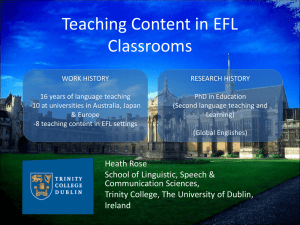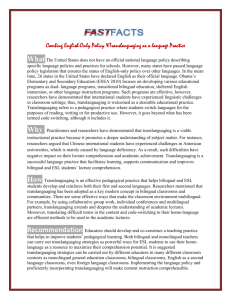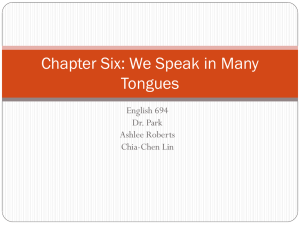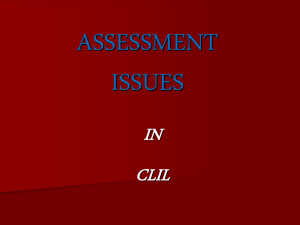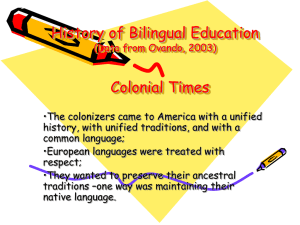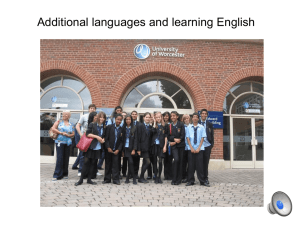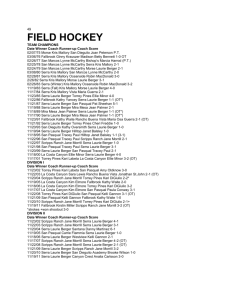Metalinguistic processing in CLIL
advertisement
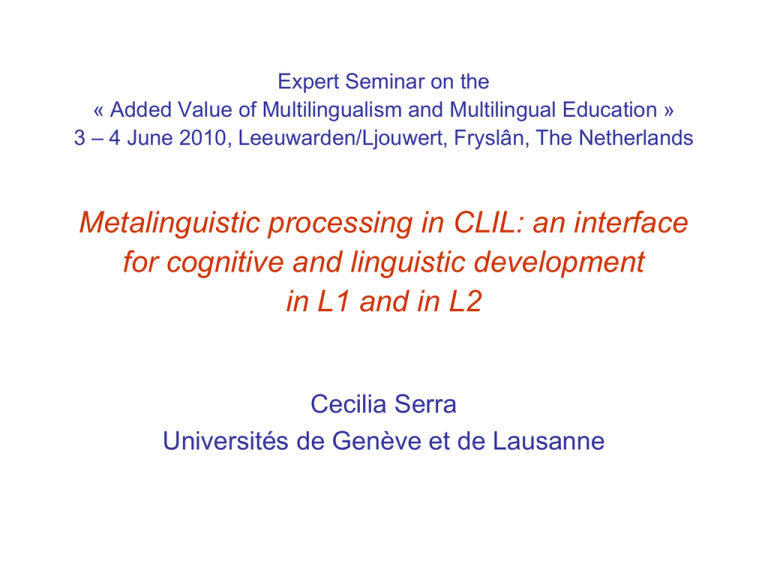
Expert Seminar on the « Added Value of Multilingualism and Multilingual Education » 3 – 4 June 2010, Leeuwarden/Ljouwert, Fryslân, The Netherlands Metalinguistic processing in CLIL: an interface for cognitive and linguistic development in L1 and in L2 Cecilia Serra Universités de Genève et de Lausanne Premise • Studies on bilingualism and on CLIL-type programmes agree that metalinguistic capacities and cognitive development are more advanced in bilinguals and in CLIL-type students than in equivalent monolingual groups; (Baetens Beardsmore, 1993; Bialystok, 1991; European Commission 2009; Garcia 2009); • However, when it comes to the specific role of « bilingual speech » (Grosjean 1985), i.e. the joint use of L1 and L2 needed to activate underlying cognitive competence, such as metalinguistic awareness, findings and opinions diverge according to the settings: – The use of L1 and L2 is a highlight of bi-plurilingual communication – The role played by L1 in bilingual education is minimized as a transitory side effect of L2 developing competence, and « boundaries have to be kept between the languages » (Baker 2006: 235). Questions • How are thought and language related, that is what is the function of language in the acquisition of concepts? • Is it possible to construct concepts in a developing L2 without the necessary linguistic competences to hand? • What is the impact of learners’ previous knowledge and of L1 in the developmental process? Organization of languages in CLIL 1. 2. 3. 4. L1 and L2 are the linguistic repertoire shared by the class; L1 and L2 form a linguistic continuum, where both languages are in the mind, even if the focus is more on L2; Movement along the continuum gives rise to translanguaging (Garcia 2008), or contact phenomena (code-switching, borrowing, etc.), which allow deeper understandings of subject meaning and linguistic competence to be co-constructed (Gajo & Serra 2000; Serra 2007); Translanguaging is exploited through metalinguistic activities. The metalinguistic activity • Translanguaging is more than translating L2 by means of L1: Transfer [...] can be considered to be a much broader process than just the extension from one language system to another. It also involves the generalization or use of knowledge from one domain to another (Bialystock & Hakuta 1999: 168) • Alternating L1/L2 in CLIL, fulfils an indexical function (Serra 2009): the choice of the language and the way in which resources from the language are juxtaposed becomes part of the message and not just a vehicle for it (Clyne 2003: 44) • Reformulating in L1 and in L2 are metalinguistic activities of form and meaning negotiation, leading to the meta-cognitive treatement of subject content. History lesson: 1st year of college, L1 = French; L2 = German T Deutschland SCHULdet Frankreich . Wiedergutmachung . Wiedergutmachung . réparation . Deutschland muss für seine . Schuld . . SCHULD . auf Französisch (L2) Germany owes damages to France . damages . (L1) réparation (L2) Germany must for its guilt . guilt in French S1 coupable (L1) guilty T coupable die Schuld genau also schuldEN . die Schuld heisst la culpabilité ok . ich schulde dir etwas . je te DOIS . quelque chose . devoir wie (L1) guilty (L2) guilt right now to owe . Shuld means (L1) guilt ok (L2) I owe you something . (L2) I owe you something. to owe (L2) as S2 Schuld ist auch eine Dette ein Dette une dette (L2) guilt is also a debt (L1) a debt T Schulden sind auch genau huh Geld dass ich ihnen zurückgeben muss genau auch es ist meine Schuld (2 sec) ich schulde dir Geld . es gibt mehrere Aspekte und das Verb schulden ich schulde dir . zehn Franken das heisst ich muss dir noch zehn Franken eh zurückgeben eh ich schulde dir Respekt ich muss respektvoll zu dir sein ok also Deutschland SCHULDET . Frankreich Wiedergutmachung das heisst . das ist eine obligation XX muss das machen Debts are also right huh money that I have to give them back right also it is my debt . I owe you money . there are several aspects and the verb to owe I owe you . ten franks that is I still have to give you ten franks back eh I owe you respect I have to be respectful towards you ok now Germany owes . France damages that means . this is an (L1) obligation (L2) XX must do this Constructing concepts in L2: Vygotski’s scientific concepts • Scientific concepts are consciously developed during teaching/learning content-matter knowledge, but they are not teacheable; • Conceptual development is a process of categorization in which meaning is systematically worked out by way of generalizations towards an integrated web of concepts; • The metalinguistic activity opens up to generalization by successive comparisons and distinctions in a gradually decontextualized use of language; • Scientific concepts are constructed on practical knowledge, or out of spontaneous/everyday concepts. Constructing concepts in L2 with L1: Vygotski’s spontaneous/everyday concepts • Spontaneous/everyday concepts are formed in communicative practice and are neither conscious nor systematic: they are used but not analyzed; • They are relatively underdeveloped relations of language and generality that become increasingly embedded in a network of logical and semantic inter-connections in the process of the development of scientific concepts (Cummins 2000: 61); • L1 conveys not only language, but learners’ spontaneous/ everyday concepts based upon their own experience and prior knowledge, and provides a foundation for interpreting textual and instructional meanings; • The contribution of L1 to the process of conceptual development in L2, and to the related development of the language, can be summarized as conceptual and linguistic mediation. 1st year of primary school: L1 = German; L2 = Italian T adesso mi metti mezzogiorno S halb . . T halb . was? [silent] T was ist giorno?9 S Tag T allora? S halb Tag T was ist halb Tag S aha Mittag T [L2] and now you put [the hands on] midday S [L1] half. . T [L1] half... [L2] what? S [silent] T [L1] what is [L2] day? S [L1] day T [L2] then? S [L1] half day T [L1] what is half day? S [L1] ah midday Organizing concepts and languages in CLIL spontaneous/everyday concepts unconscious not analyzed not systematic metalinguistic activity generalize scientifics concepts conscious analyzed web of logic & semantic interconnections decontextualize L1 categorize L2 familiar unfamiliar transparent opaque analyzable not analyzed code-switching How to improve students’ L1 through CLIL • Categorizing can be taught to arouse students’ representations (everyday concepts) and transform them into scientific concepts by means of conceptual mapping and semantic clusters, in (inter)disciplinary activities (Val d’Aoste); • Metalinguistic development of language pushes students to put their own continuum in use and to test its pertinence (Ecole internationale de Genève, Ecole Montessori); • Making the school’s L1 “unfamiliar” develops competence in this language; • Plurilingual practice and translanguaging in class legitimatize students’ own experience, and supports ethnic and family use. References • • • • • • • • • • • Baetens Beardsmore, H. 1999. Consolidating experience in plurilingual education. In : D. Marsh and B. Marsland (eds), CLIL Initiatives for the Millennium. University of Jyväskylä : Continuing Education Centre, 24-30. Baker, C. (2006). Foundations of Bilingual Education and Bilingualism. Clevedon : Multilingual Matters, 4th. Bialystok, E. 1991. Language processing in bilingual children.Cambridge: Cambridge UP. Bialystock, E. & Hakuta, K. 1999. Counfounded Age : Linguistic and Cognitive factors in Age Differences for Second Language Acquisition. In : Birdsong, D. (ed) Second Language Acquisition and the Critical Period Hypothesis. New Jersey, London : Lawrence Erlbaum Ass., 161-181. Clyne, M. (2003) Toward a More Language-Centred Approach to Plurilingualism. In : Dewaele, J.-M., Housen, A. & Li Wei (eds.) Bilingualism : Beyond Basic Principles. Clevedon : Multilingual Matters, 43-55. Cummins, J. (2000). Language, Power and Pedagogy. Clevedon : Multilingual Matters. Gajo, L. and Serra, C. (2000). Bilingual Teaching: Connecting Language and Concepts in Mathematics. In: So, D.W.C. and Jones G.M. (eds.) Education and Society in Plurilingual Contexts. Garcia, O. 2009. Bilingual Education in the 21st Century. A Global Perspective. Oxford: Wiley-Blackwell. Grosjean, F. 2001. The bilingual's language modes. In Nicol, J. (ed). One Mind, Two Languages: Bilingual Language Processing (pp. 1-22). Oxford: Blackwell. Maillat, D. et Serra C. 2008. Bilingual Education and Cognitive Strategies: Can the Obstacle Be the Advantage?. International Journal of Multilingualism,6:2,186 - 206. Serra, C. 2007. Assessing CLIL at Primary School : A longitudinal Study. International Journal of Bilingual Education and Bilingualism 10/5, 582-602.

